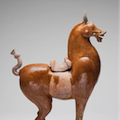GALLERY 1600 | EARLY CHINESE ART
 The Zhou was a powerful state in the region of modern-day Shaanxi province in northern China. It came to power after overthrowing the area’s Shang rulers in the mid-11th century BCE. In an effort to establish its cultural legitimacy, the Zhou adopted its predecessors’ religious rites; the result was the uninterrupted manufacture of the kinds of ritual bronze vessels and jade implements that had been the sacred tomb furnishings of the Shang elite. In the eighth century BCE, however, attacks by nomadic invaders forced Zhou rulers to abandon their capital in modern-day Xi’an, Shaanxi province, and flee eastward to present-day Luoyang, Henan province; they never again controlled a unified state. This move marks the division between the Western and Eastern Zhou periods, (c. 1050–771 and 770–256 BCE, respectively). The Eastern Zhou era saw a proliferation of luxury goods made of gold, silver, and lacquer being used as tomb objects, buried alongside the traditional bronzes and jades.
The Zhou was a powerful state in the region of modern-day Shaanxi province in northern China. It came to power after overthrowing the area’s Shang rulers in the mid-11th century BCE. In an effort to establish its cultural legitimacy, the Zhou adopted its predecessors’ religious rites; the result was the uninterrupted manufacture of the kinds of ritual bronze vessels and jade implements that had been the sacred tomb furnishings of the Shang elite. In the eighth century BCE, however, attacks by nomadic invaders forced Zhou rulers to abandon their capital in modern-day Xi’an, Shaanxi province, and flee eastward to present-day Luoyang, Henan province; they never again controlled a unified state. This move marks the division between the Western and Eastern Zhou periods, (c. 1050–771 and 770–256 BCE, respectively). The Eastern Zhou era saw a proliferation of luxury goods made of gold, silver, and lacquer being used as tomb objects, buried alongside the traditional bronzes and jades.
By the end of the Eastern Zhou period, ideas of the afterlife were shifting, and philosophers of the day inveighed against elaborate burials. By the Qin (221–206 BCE) and Han (206 BCE–220 CE) dynasties, as a belief in immortality took hold, both the structure and the contents of tombs began to change. Whereas Shang and Zhou tombs were essentially pits made to hold the dead and the items they would need in the afterlife, Qin and Han tombs were multi-chambered dwellings they could inhabit for all eternity. Ceramic replicas of vessels, architectural structures, domesticated animals, and servants replaced the precious objects (and living creatures) that had been interred in Bronze Age tombs.
A protracted period of disunity followed the Han dynasty, before the country was again unified under imperial rule by the Sui (581–618) and Tang (618–907) dynasties. During the post-Han period, as China’s contact with foreign cultures to its west increased, tomb sculptures began to depict foreigners and exotic animals. Known as China’s Golden Age, the Tang dynasty was a long period of peace, prosperity, and territorial expansion, famous for its literary and artistic achievements.
November 16, 2014 (Inaugural) – present





